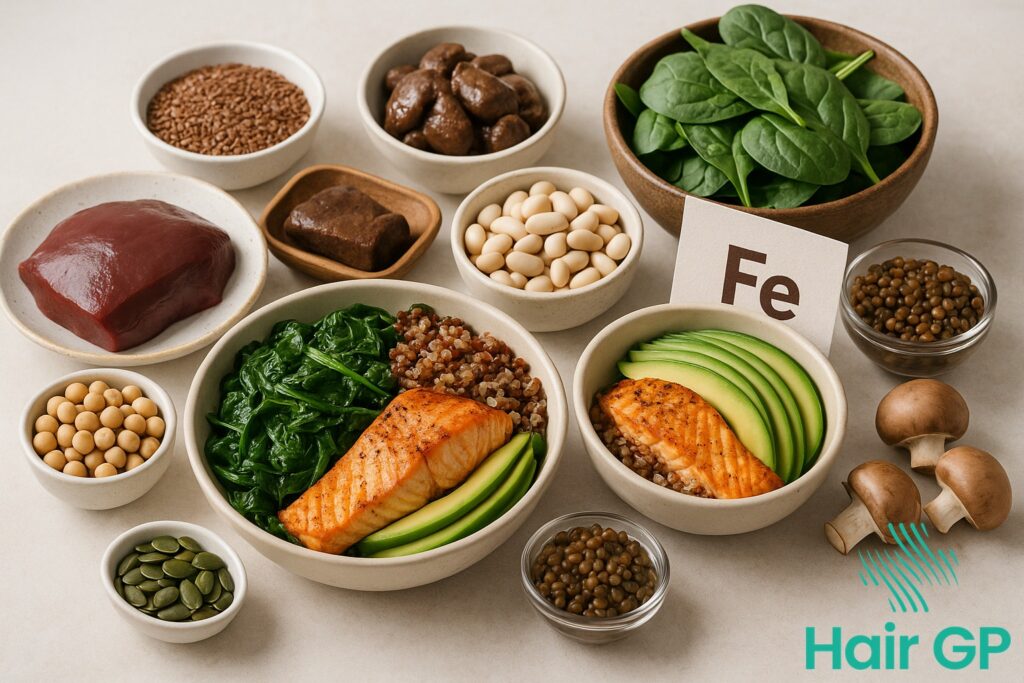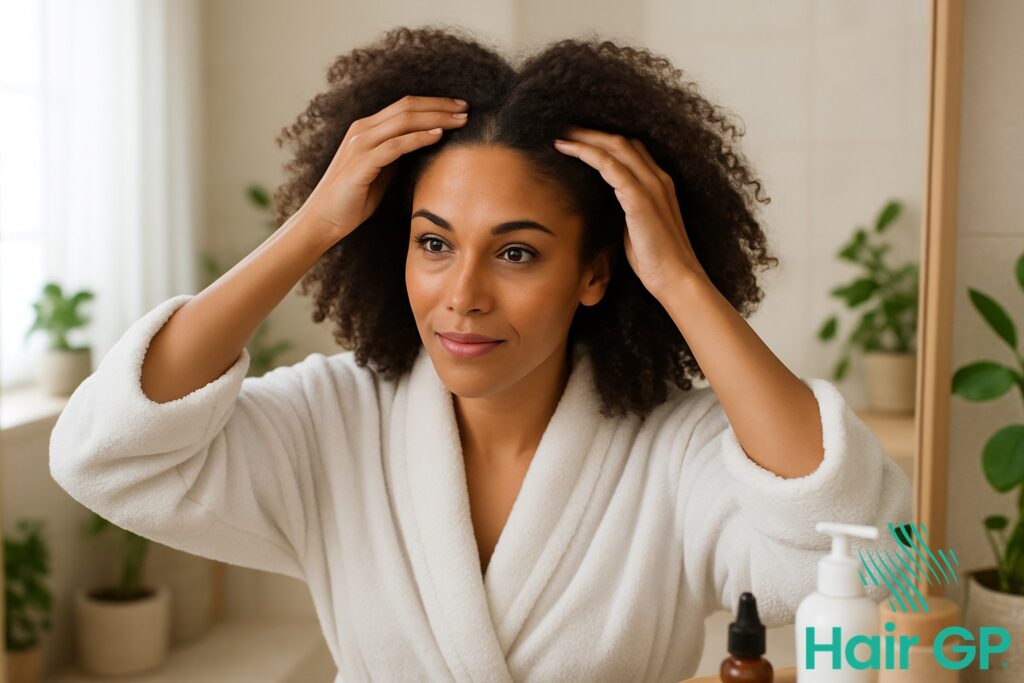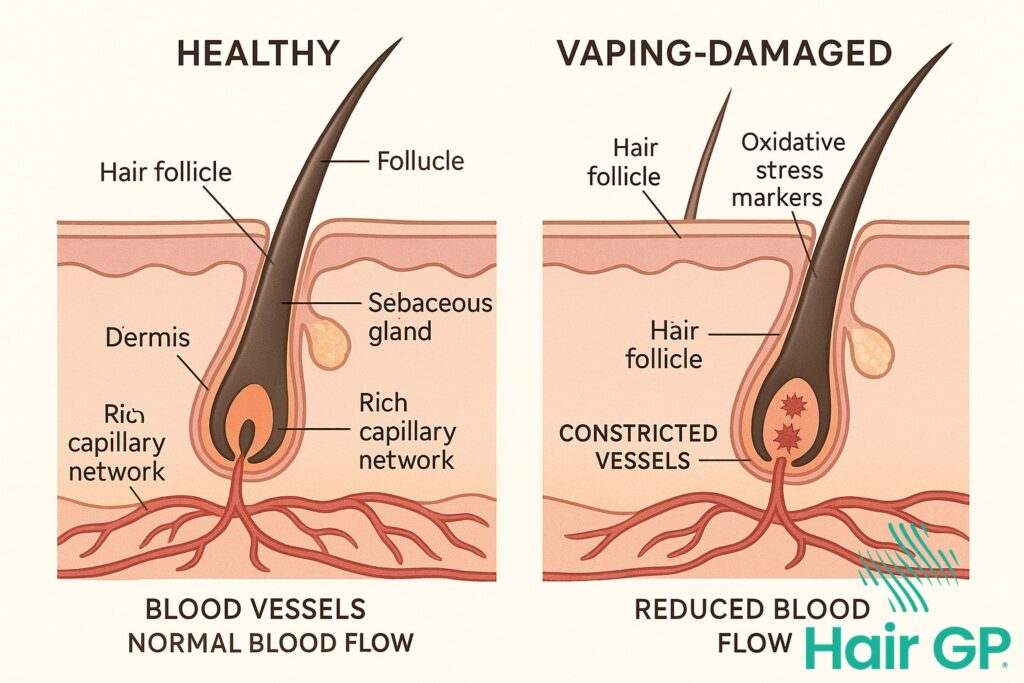Introduction
Discovering clumps of hair in your shower drain or on your pillow can be alarming, especially when it seems to happen suddenly. If you’re experiencing significant hair loss, you may be dealing with telogen effluvium, one of the most common forms of temporary hair thinning that affects millions of people worldwide. This condition often stems from various triggers, with iron deficiency being a particularly prevalent underlying cause that’s frequently overlooked.
The good news is that telogen effluvium related to nutritional deficiencies is typically reversible through strategic dietary interventions. When your body lacks adequate iron, hair follicles don’t receive the oxygen and nutrients they need to maintain healthy hair growth cycles. By incorporating iron rich foods into a balanced diet, you can address the root cause and support your hair’s natural recovery process.
This comprehensive guide provides you with everything needed to combat hair loss through targeted nutrition. You’ll discover the scientific connection between iron and hair health, learn to identify the most effective dietary sources of iron, and receive a complete week-long meal plan designed specifically for hair recovery. We’ll also explore supporting nutrients that enhance iron absorption, share practical meal preparation strategies to make the plan manageable, and identify foods that could hinder your progress. Additionally, you’ll learn realistic timelines for seeing improvement and methods for tracking your hair’s recovery journey, empowering you to take control of your hair health through informed nutritional choices.
Key Takeaways – TL/DR
- Iron deficiency is a leading nutritional cause of telogen effluvium and temporary hair loss
- A structured 7-day iron-rich meal plan can help restore iron levels and support hair recovery
- Combining iron-rich foods with vitamin C enhances iron absorption for optimal hair health
- Consistent nutrition over 3-6 months is typically needed to see significant hair improvement
Understanding Telogen Effluvium and Iron Deficiency
Telogen effluvium represents the most common form of diffuse hair thinning, affecting approximately 5% of dermatology patients seeking treatment for significant hair loss [1]. This condition occurs when hair follicles prematurely enter the resting phase of the hair growth cycle, causing increased shedding typically 2-3 months after a triggering event. Unlike pattern baldness, telogen effluvium affects the entire scalp uniformly and is generally reversible when underlying causes are addressed.
Iron deficiency stands as one of the most prevalent nutritional deficiencies worldwide, affecting nearly 25% of the global population [2]. When iron levels drop below optimal ranges, the body prioritizes essential functions over hair growth, disrupting the normal hair cycle. Iron serves as a crucial cofactor in DNA synthesis and cellular energy production within hair follicles, making adequate levels essential for maintaining healthy hair growth. Even subclinical iron deficiency can trigger telogen effluvium episodes, causing noticeable hair loss before other symptoms appear.
Proper nutrition plays a fundamental role in hair recovery from telogen effluvium. Restoring iron levels through targeted dietary interventions can help normalize hair growth cycles and prevent future episodes of hair thinning.
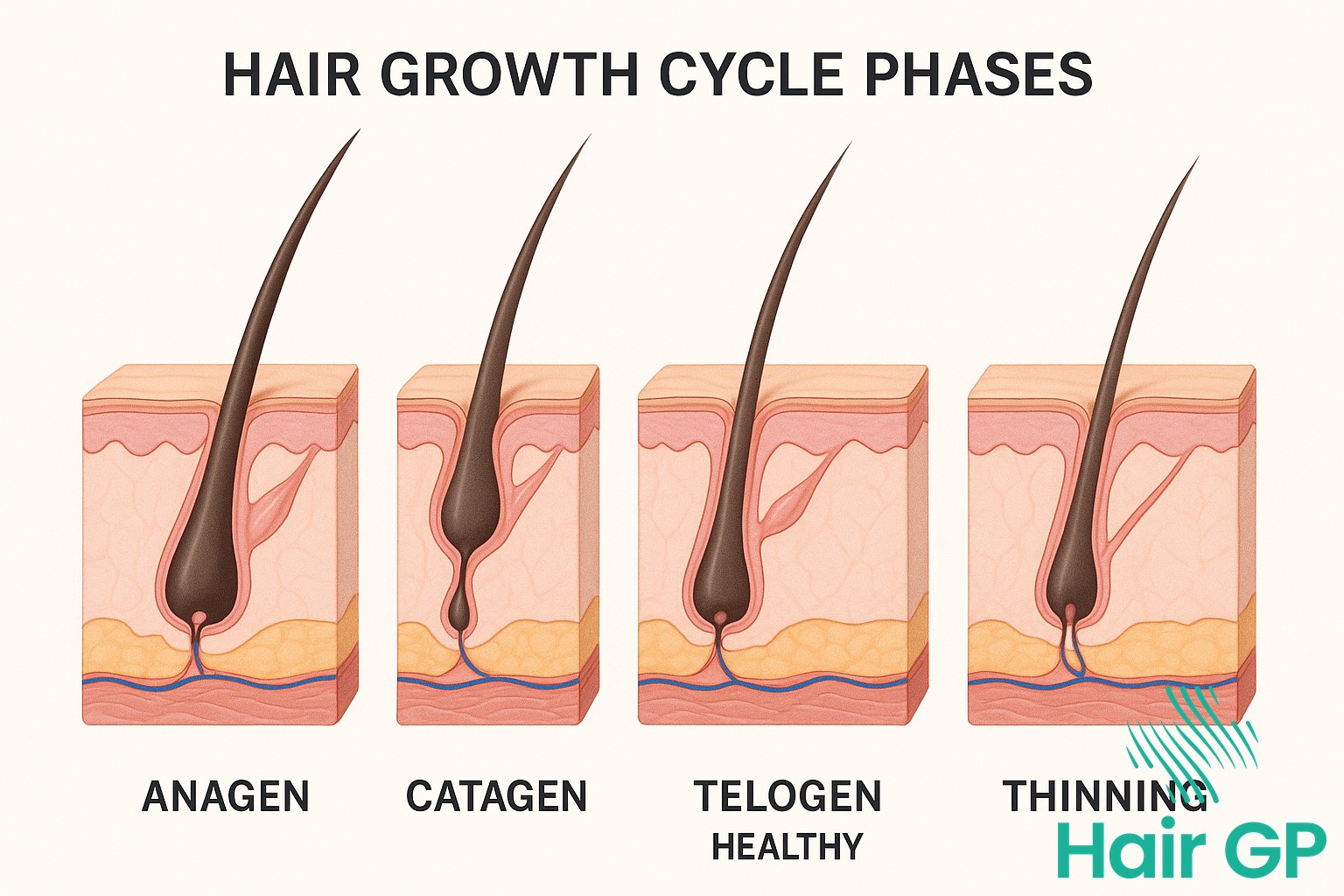
The Science Behind Iron and Hair Health
Iron plays a crucial role in maintaining healthy hair through several key biological pathways. Iron levels directly influence hair follicle function by supporting the production of haemoglobin, which carries oxygen to scalp tissues and hair roots [2]. This oxygen delivery is essential for cellular metabolism within the hair follicle, enabling the rapid cell division necessary for continuous hair growth.
Additionally, iron serves as a cofactor for various enzymes involved in protein synthesis, particularly those responsible for producing keratin, the primary structural protein in healthy hair [3]. When iron levels are adequate, these processes support hair growth by ensuring follicles receive proper nutrition and maintain their growth cycle. Poor iron absorption can disrupt these mechanisms, leading to weakened hair shafts and increased shedding. Research demonstrates that optimising iron levels through dietary interventions can support scalp health and restore normal hair growth patterns, validating the importance of iron-rich meal planning for individuals experiencing hair thinning.
Essential Iron-Rich Foods for Hair Health
Building an effective iron-rich meal plan requires understanding key nutrients from different sources. These nutrient rich foods include heme iron from animal products and non-heme iron from plants, each with distinct absorption rates.
Animal-Based Iron Sources
Heme iron offers superior bioavailability with 15-35% absorption rates. Lean beef provides 3.2mg per serving, chicken delivers 1.3mg, while seafood like oysters contain 5.11mg per serving, making them excellent iron rich ingredients.
Plant-Based Iron Powerhouses
Plant-based iron rich foods need strategic pairing for optimal absorption. Leafy greens like spinach offer 6.4mg per cooked cup, legumes provide 3-6mg per serving. When you eat foods rich in vitamin C alongside these ingredients, iron absorption increases significantly.
Iron Content Comparison Guide
Iron content varies significantly: beef liver provides 18mg (100% DV), fortified cereals offer 18mg, spinach contains 6.4mg (36% DV), and lentils provide 6.6mg per serving. Understanding these key nutrients helps optimize daily iron intake effectively.
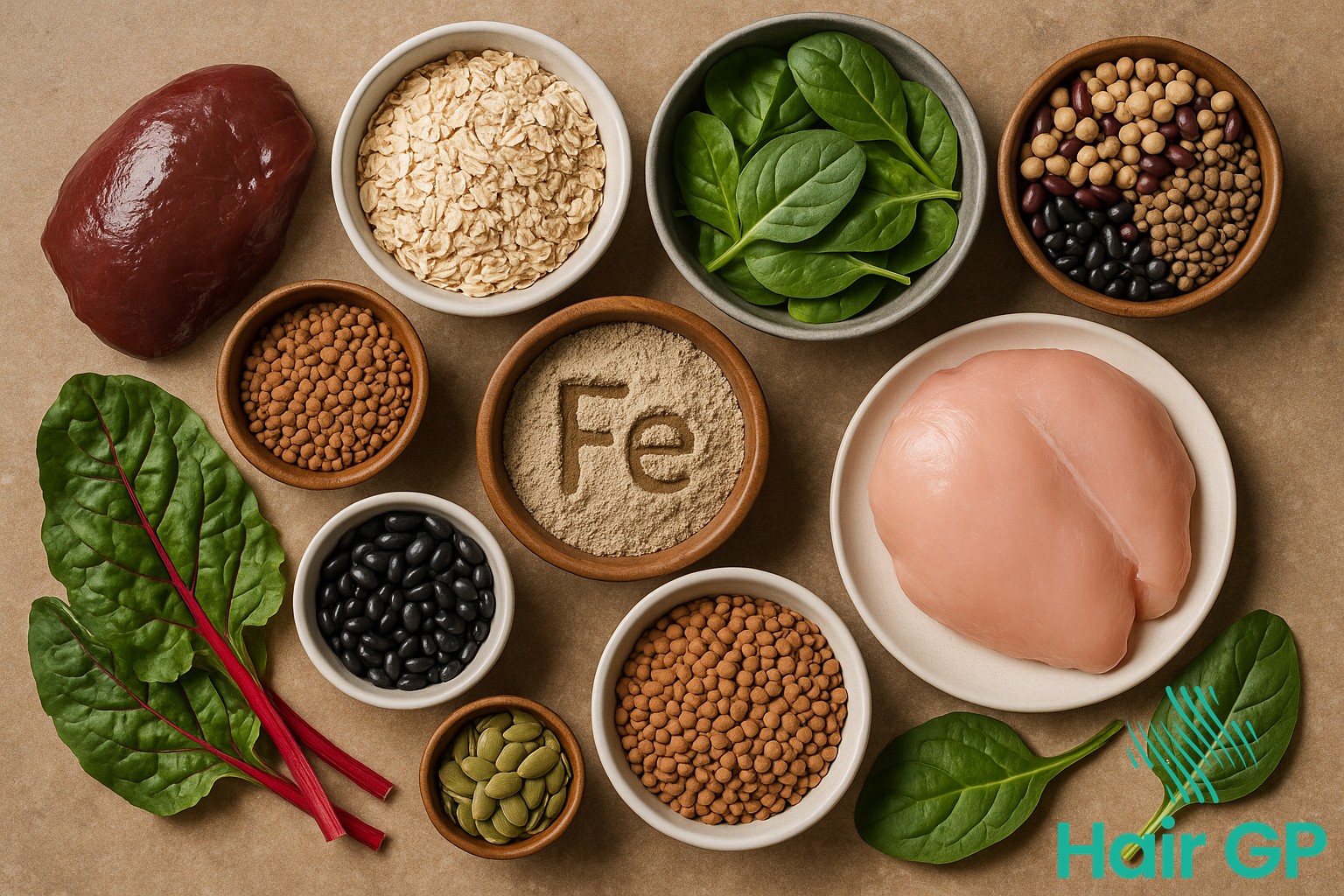
Your Complete 7-Day Iron-Rich Meal Plan
This comprehensive 7-day meal plan transforms your daily eating routine into a powerful tool for hair restoration. Each day strategically combines iron rich foods with supporting nutrients to create balanced diet foundations that nourish your hair from within.
Days 1-2: Foundation Building Meals
Begin your journey with fortified whole grain cereals paired with sliced strawberries and milk for breakfast, delivering immediate iron absorption benefits. Lunch features grilled chicken breast with quinoa and steamed broccoli, providing heme iron alongside vitamin C for enhanced uptake. Dinner combines lean beef with sweet potato and spinach salad, creating nutrient dense foods combinations that support hair follicle health. Mid-morning snacks include pumpkin seeds with dried apricots, while afternoon options feature hummus with bell pepper strips.
Days 3-4: Balanced Variety Approach
Expand your meal plans with plant-based iron sources like lentil and tomato soup paired with whole grain rolls for lunch. Breakfast transitions to iron-fortified oatmeal topped with chopped almonds and raisins. Evening meals feature baked salmon with asparagus and brown rice, integrating omega-3 fatty acids with iron absorption enhancers. Incorporate tofu stir-fry with bok choy and sesame seeds, demonstrating how diverse protein sources create satisfying meals while meeting iron requirements. Snack options include trail mix combining cashews, dried fruit, and dark chocolate chips.
Days 5-7: Optimisation and Sustainability
Establish long-term sustainable patterns with make-ahead meals like turkey and white bean chili, which provides both heme and non-heme iron sources. Breakfast smoothies blend spinach, banana, and fortified plant milk for quick preparation. Implement batch cooking strategies by preparing large portions of iron-rich staples like quinoa pilaf with chickpeas and roasted vegetables. Focus on absorption optimization by pairing iron sources with vitamin C-rich foods and avoiding tea or coffee with meals. Streamline preparation through weekend meal prep sessions, ensuring consistent access to nutrient dense foods throughout busy weekdays. These sustainable approaches transform your diet into an ongoing hair health support system.
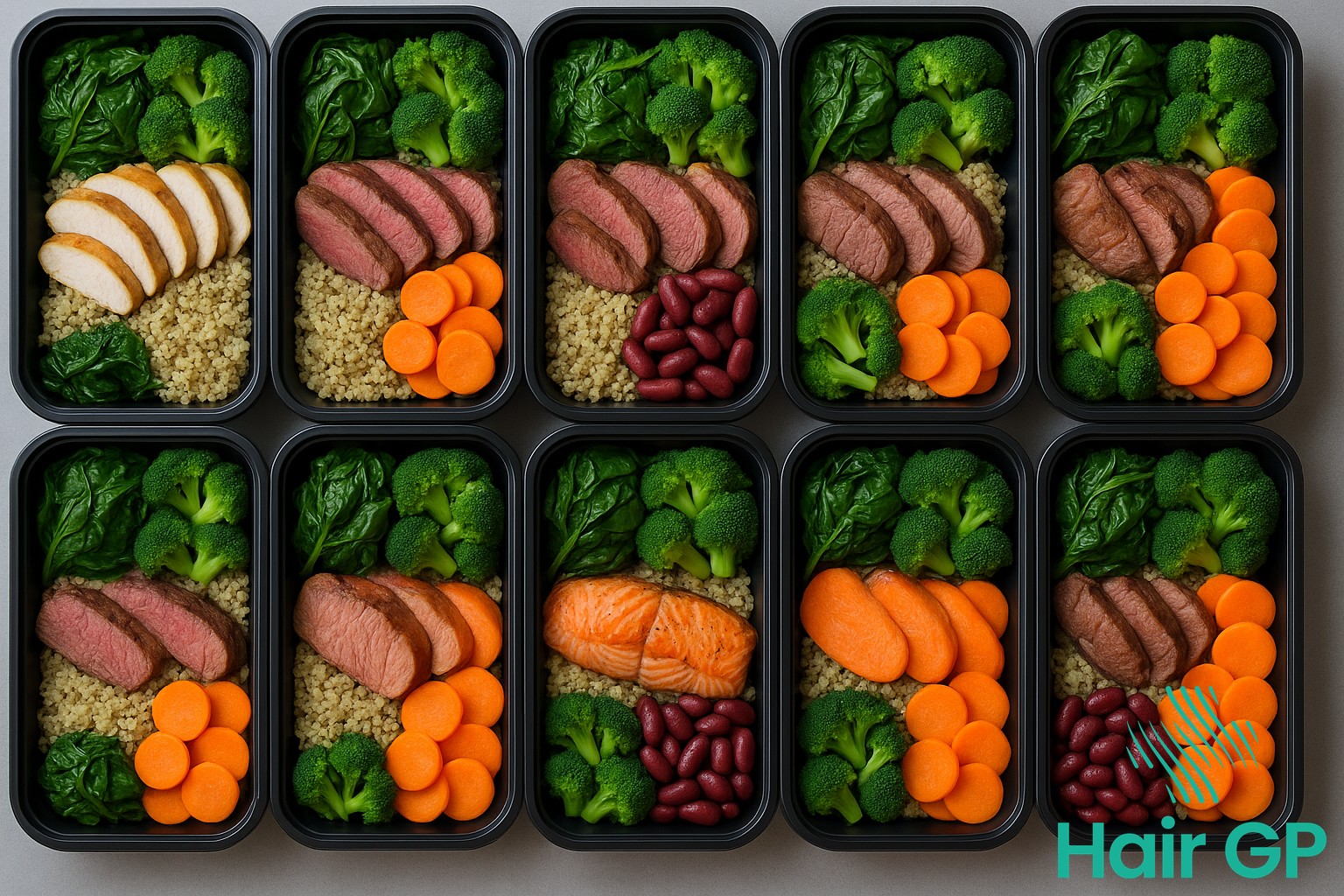
Supporting Nutrients for Healthy Hair Growth
While iron is fundamental for hair health, essential vitamins and nutrients work synergistically to maximize its effectiveness. These complementary nutrients enhance iron absorption and directly support hair follicle function for optimal growth.
Vitamin C for Enhanced Iron Absorption
Vitamin C dramatically enhances iron absorption from plant-based sources by converting iron into a more bioavailable form. Citrus fruits, bell peppers, strawberries, and leafy greens provide high vitamin C content that can increase non-heme iron absorption by up to 300%. Consuming vitamin C-rich foods alongside iron-rich meals optimizes nutrient uptake and support hair health.
B-Vitamins and Protein Synergy
B-vitamins, particularly biotin, folate, and B12, work alongside adequate protein intake to support hair structure and growth. Biotin rich foods like eggs and nuts strengthen hair shafts, while protein rich foods provide essential amino acids for keratin production. Getting enough protein daily, combined with these essential vitamins, creates synergistic effects that maximize hair follicle health and growth potential.
Meal Prep and Planning Strategies
Successfully implementing iron-rich meal plans requires strategic preparation and organization. These practical strategies transform complex nutrition goals into manageable daily routines, ensuring your nutrient rich diet supports promoting healthy hair growth consistently.
Weekly Prep Tips
Batch cooking iron-rich proteins like lean meats and legumes on weekends maximizes efficiency throughout the week. Pre-washing leafy greens, chopping vegetables, and portioning ingredients streamline daily meal preparation. Cook grains in larger quantities and store portions for quick balanced diet assembly during busy weekdays.
Storage and Safety Guidelines
Properly stored prepared meals maintain nutritional integrity for 3-4 days in refrigeration. Store iron-rich foods in airtight containers to preserve nutrients and prevent oxidation. Label containers with preparation dates and reheat meals to 165°F to ensure food safety while maintaining the quality of your diet focused on promoting healthy hair growth.
Foods to Limit During Hair Recovery
Certain foods and beverages can significantly hinder iron absorption, potentially undermining efforts to improve hair health. Coffee and tea contain tannins that bind to iron, reducing iron levels when consumed with meals. Dairy products high in calcium can interfere with iron intake, making it harder to combat hair loss effectively.
Processed foods often contain preservatives that may worsen hair shedding, while excessive whole grains introduce phytates that block iron absorption. To optimize recovery, space coffee and tea consumption at least one hour from iron-rich meals. Replace dairy milk with plant-based alternatives during meals, and temporarily choose refined grains. These adjustments help maximize iron absorption and reduce hair shedding during recovery.
Tracking Progress and Expected Results
Setting realistic expectations is crucial when using dietary changes to improve hair health and prevent hair loss. Hair growth occurs in cycles, and visible improvements typically emerge after three to six months of consistent nutritional support [4]. During this period, focus on tracking subtle changes like reduced hair shedding, increased shine, and stronger hair texture rather than expecting dramatic length increases immediately. Document progress through monthly photos, noting overall hair health improvements and any areas showing thicker hair development. Keep a simple journal recording daily nutrition intake and any changes in hair quality. While dietary interventions effectively support strong and healthy hair, combining proper nutrition with gentle hair care practices maximizes results. If minimal improvement occurs after six months of dedicated nutritional focus, consider consulting professionals for additional strategies beyond dietary modifications to enhance hair growth outcomes.
Conclusion
Achieving optimal hair health through targeted nutrition requires dedication and strategic planning. This comprehensive 7-day iron-rich meal plan provides the foundation necessary to combat iron deficiency and support hair growth during telogen effluvium recovery. By incorporating diverse iron rich foods into your daily routine, you create an environment conducive to healthy hair growth.
The journey to hair restoration demands patience and consistency. Hair follicles respond gradually to improved nutrition, with visible improvements typically appearing after 3-6 months of sustained dietary changes. Regular consumption of iron-rich proteins, leafy greens, and complementary nutrients establishes the nutritional foundation your body needs to reverse telogen effluvium effectively.
Remember that individual responses to dietary interventions vary significantly. While this meal plan addresses common nutritional deficiencies associated with hair loss, persistent or severe hair thinning warrants professional medical evaluation. Healthcare providers can identify underlying conditions, recommend appropriate diagnostic tests, and develop personalized treatment strategies beyond nutritional support.
Embrace this meal plan as your starting point toward healthier hair. Consistency in following iron-rich dietary patterns, combined with patience during the recovery process, creates the optimal conditions to support hair growth and restore your confidence in your hair’s natural beauty.
Frequently Asked Questions
Most people notice reduced hair shedding within 4-6 weeks of following an iron-rich meal plan, with visible new hair growth typically appearing after 3-4 months of consistent nutrition. Individual results vary based on initial iron levels and overall health.
Absolutely. The meal plan includes extensive plant-based iron sources like leafy greens, legumes, and fortified foods. Combine these with vitamin C-rich foods to enhance absorption, and consider having iron levels monitored by your healthcare provider.
Iron supplements should only be taken under medical supervision after blood testing confirms deficiency. This meal plan focuses on natural food sources, which are generally safer and provide additional beneficial nutrients for hair health.
The meal plan offers flexibility with multiple options for each meal. Focus on the iron-rich foods you enjoy and use the substitution guide to replace items you don’t prefer while maintaining similar iron content.
References
- Grover C, Khurana A. Telogen effluvium. Indian J Dermatol Venereol Leprol. 2013. PMID: 23974577
- Trost LB, Bergfeld WF, Calogeras E. The diagnosis and treatment of iron deficiency and its potential relationship to hair loss. J Am Acad Dermatol. 2006. PMID: 16635664
- Park SY, Na SY, Kim JH, Cho S, Lee JH. Iron plays a certain role in patterned hair loss. J Korean Med Sci. 2013. PMID: 23772161
- Almohanna HM, Ahmed AA, Tsatalis JP, Tosti A. The Role of Vitamins and Minerals in Hair Loss: A Review. Dermatol Ther (Heidelb). 2019. PMID: 30547302

